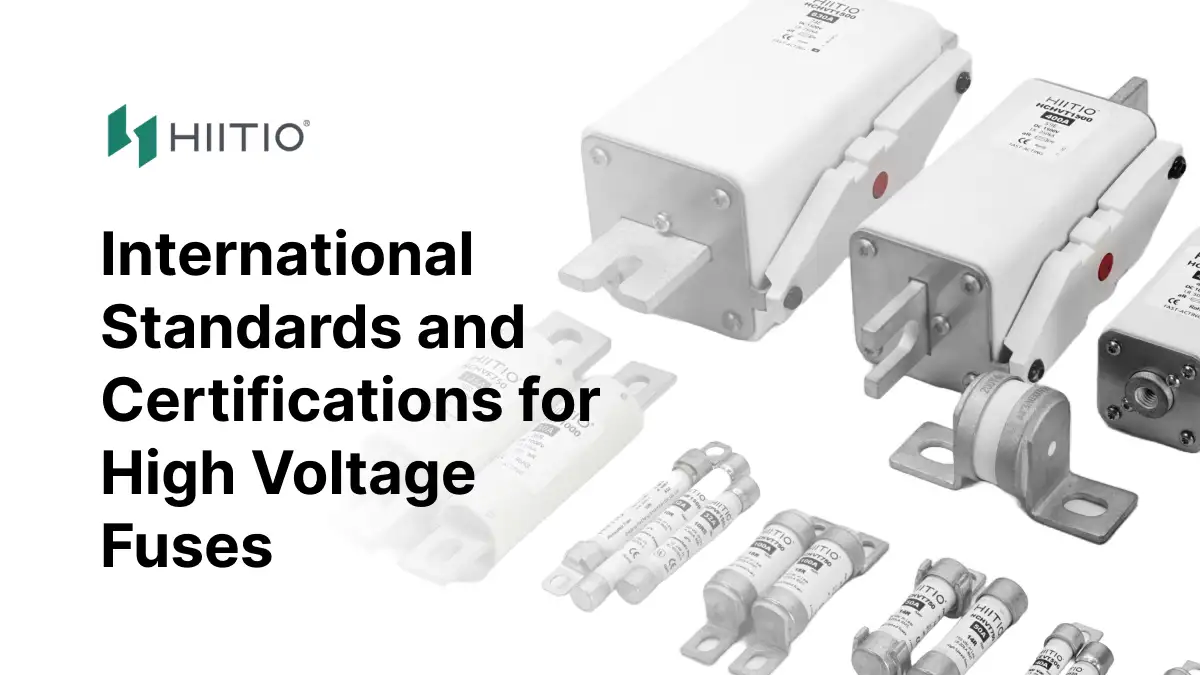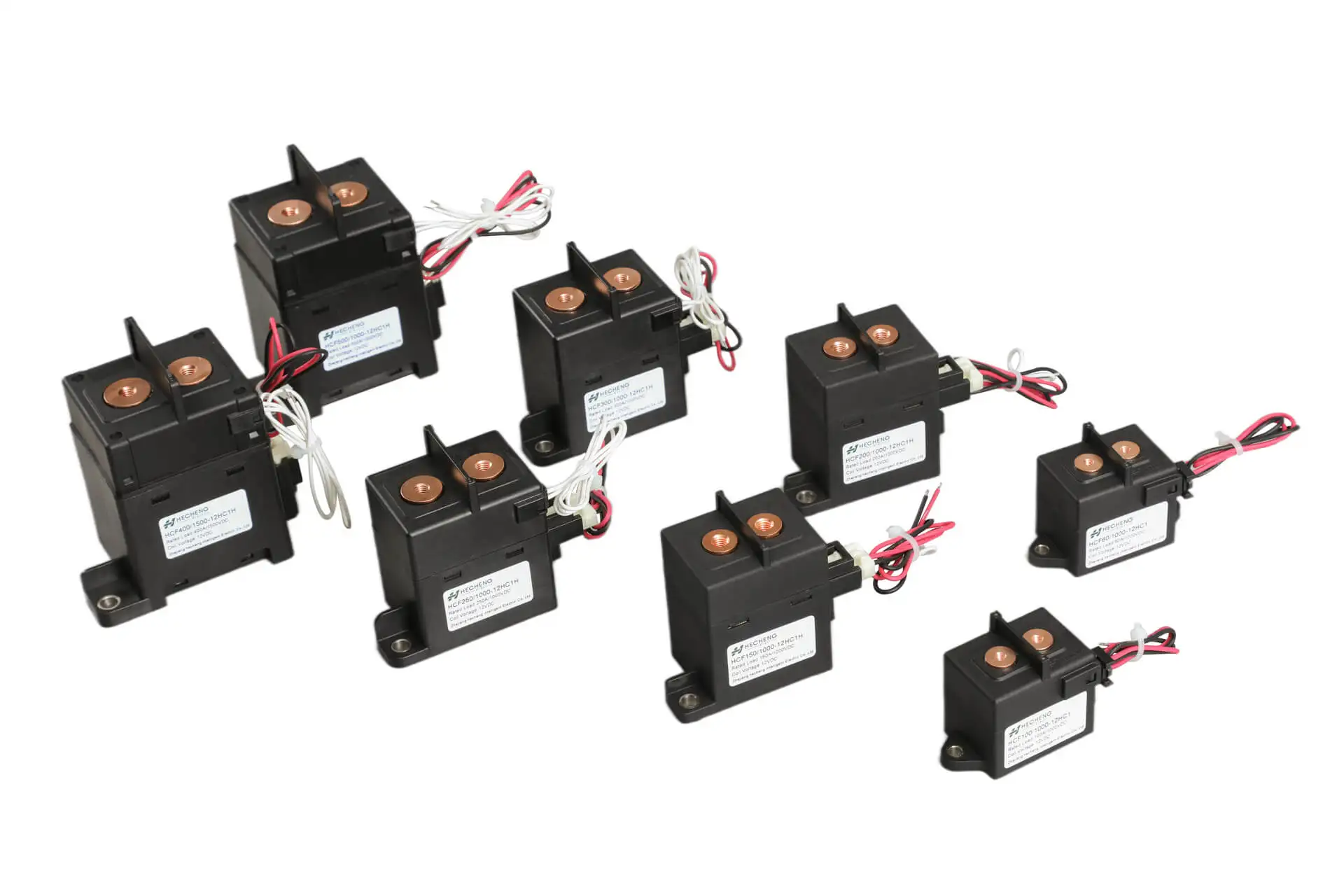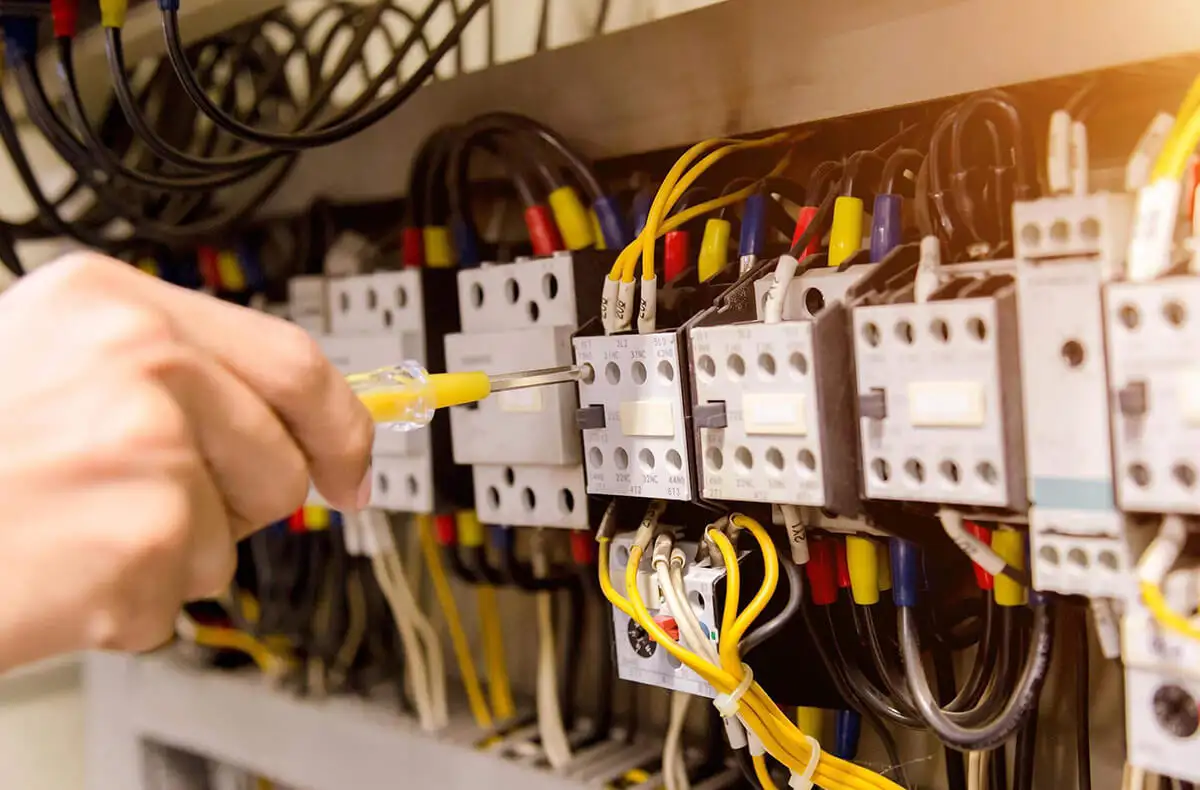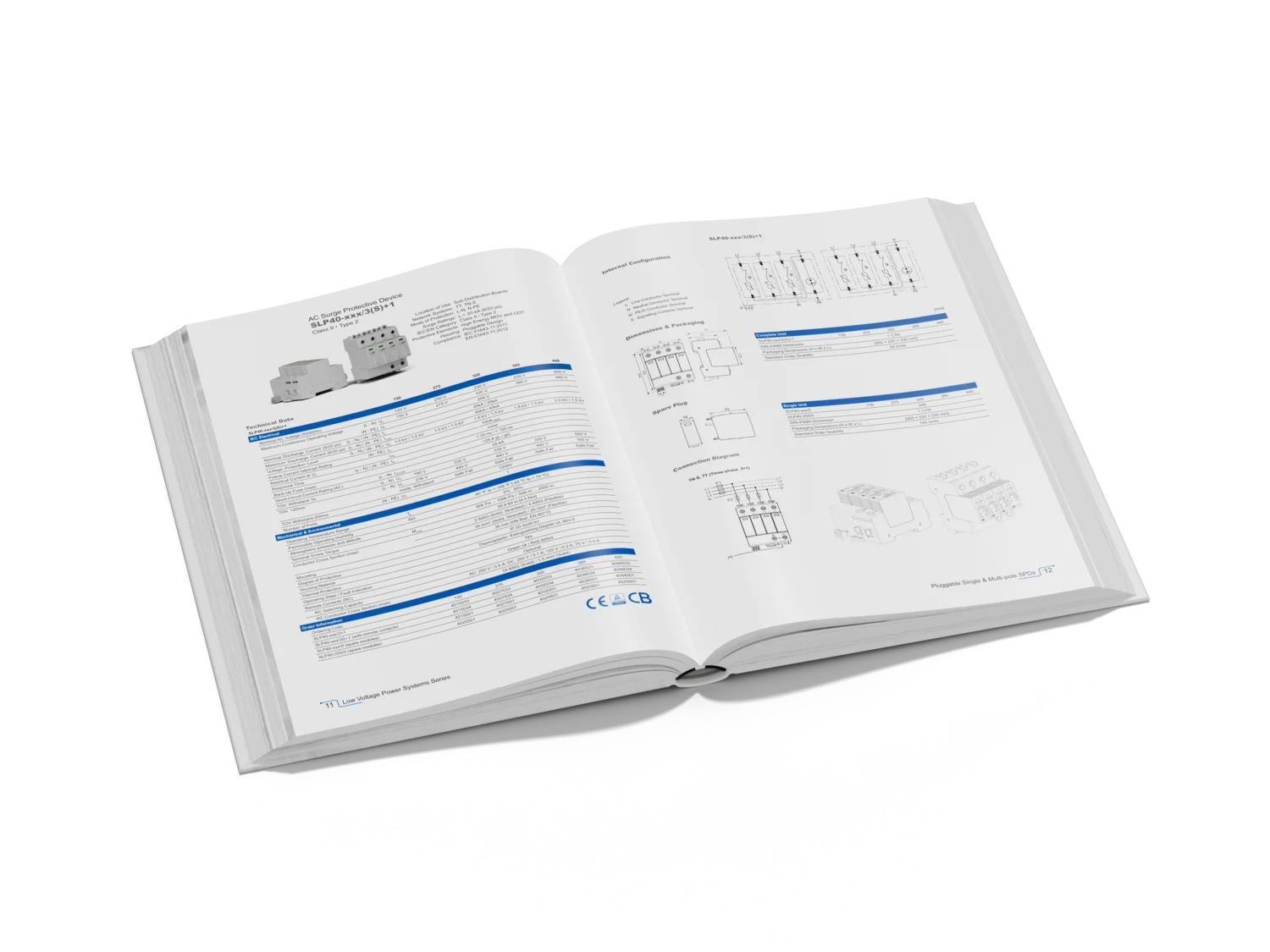High Voltage Direct Current (HVDC) fuses are essential components in modern power systems, particularly in energy storage systems, electric vehicles (EVs), and renewable energy applications. As global markets increasingly demand efficient, reliable, and safe electrical solutions, manufacturers must adhere to international standards and certifications to ensure product quality and market acceptance. This article explores the importance of these standards and certifications in the HVDC fuse industry, focusing on how HIITIO New Energy’s HV DC Fuses comply with and exceed these global requirements.
The Role of HVDC Fuses in Modern Electrical Systems
High-voltage direct current fuses are critical for protecting electrical systems against overcurrent and short circuits. These fuses are specifically designed for environments where DC voltage is high, such as energy storage systems, EV charging infrastructure, photovoltaic (PV) systems, and other industrial applications. Unlike their AC counterparts, HVDC fuses face unique challenges such as arc extinguishing and maintaining stability under high DC loads.
As these technologies continue to evolve, the demand for HVDC fuses with high breaking capacities, fast response times, and long lifespans has surged. This growing need also emphasizes the importance of standardization and certification, as improper fuse performance could result in system failures, equipment damage, or, worse, safety hazards.
Key International Standards for HVDC Fuses
To ensure that HVDC fuses meet the necessary safety and performance criteria, several international standards have been established by recognized bodies such as the International Electrotechnical Commission (IEC), Underwriters Laboratories (UL), Japanese Automotive Standards Organization (JASO), and the International Organization for Standardization (ISO). Below are the most relevant standards for HVDC fuses:
- JASO-D622: Issued by the Japanese Automotive Standards Organization (JASO), JASO-D622 focuses on fuses for automotive applications, particularly for electric and hybrid vehicles. Given the increasing role of HVDC fuses in electric vehicles, compliance with this standard ensures optimal safety and performance in the automotive sector.
- ISO 8820: This international standard is focused on fuses for road vehicles, ensuring the safe and reliable protection of automotive electrical circuits. HVDC fuses that meet ISO 8820 standards are recognized globally for their suitability in electric and hybrid vehicle applications.
- IATF 16949: IATF 16949 is the international standard for automotive quality management systems. Compliance with IATF 16949 demonstrates that manufacturers have robust processes in place to produce high-quality products, including HVDC fuses, for the automotive sector. This certification is critical for manufacturers supplying components to the global automotive industry.
- IEC 60269: This is the core international standard governing low-voltage fuses, including those used for direct current applications. IEC 60269 outlines the requirements for fuse construction, performance, and testing. Fuses that comply with this standard undergo rigorous testing for short-circuit protection, overload performance, and environmental durability:
IEC 60269-1: General Requirements
IEC 60269-1 forms the basis of the standard and applies to all types of low-voltage fuses. It defines the general requirements, terminology, and testing methods for fuses. Key aspects covered include:
- Basic Definitions: Terminology like fuses, fuse links, and fuse elements are clearly defined to standardize descriptions of various fuse types.
- Construction Requirements: Specifications regarding fuse construction, including materials, shapes, and sizes, are outlined.
- Electrical Performance: Key electrical parameters like rated voltage, rated current, and breaking capacity are defined.
- Temperature Rise: Specifies limits for the temperature rise of fuses in operation to prevent overheating.
- Test Methods: Provides detailed testing procedures to evaluate fuse performance, such as short-circuit tests, overload tests, and environmental endurance tests.
For HVDC fuses, these general requirements ensure the fundamental performance of fuses in high-voltage DC systems, particularly in terms of breaking capacity and temperature management under extreme operating conditions.
IEC 60269-2: Low-Voltage Industrial Fuses
IEC 60269-2 focuses on low-voltage industrial fuses, which are used in high-power industrial equipment like motors, transformers, and motor control systems. Key features include:
- Time-Current Characteristics: This section details the time-current behavior of fuses, ensuring they respond appropriately to different levels of overcurrent or short circuits.
- Environmental Conditions: Specifies performance in harsh industrial environments, including temperature extremes, humidity, and dust.
- High Breaking Capacity: Requires fuses to handle large short-circuit currents to protect equipment from damage and to ensure personal safety.
Though primarily designed for AC industrial equipment, the high breaking capacity and time-current characteristics of these fuses provide useful insights for designing HVDC fuses, which require robust protection against overloads and short circuits in industrial settings.
IEC 60269-3: Fuses for Domestic and Similar Applications
IEC 60269-3 applies to low-voltage fuses used in domestic and similar environments. This part of the standard specifies the dimensions, construction, performance, and safety requirements for fuses in household and small commercial applications, including:
- Dimensions and Installation: Standardizes fuse dimensions and installation to ensure interchangeability and ease of replacement.
- Short-Circuit and Overload Protection: Fuses must provide adequate protection against short circuits and overloads to prevent fires and damage to household electrical equipment.
- Safety Requirements: High reliability is required to ensure safety and functionality over the long term in residential settings.
While this part primarily addresses AC systems, its focus on safety and reliability is also crucial for HVDC fuses used in home energy storage systems, EV chargers, and small-scale PV systems.
IEC 60269-4: Fuses for the Protection of Semiconductor Devices
IEC 60269-4 specifically addresses fuses designed to protect semiconductor devices. Semiconductors, such as diodes, thyristors, and rectifiers, are highly sensitive to overcurrent conditions, especially in DC systems. Key aspects include:
- Fast-Blow Characteristics: Fuses must interrupt overcurrents quickly to prevent permanent damage to semiconductor devices.
- Low Power Loss: Fuses should operate with minimal power loss to ensure energy efficiency in the overall system.
- DC Protection: This part of the standard specifically considers the protection of semiconductors in DC environments, which is critical for HVDC applications.
For HVDC fuses, compliance with IEC 60269-4 is vital in protecting semiconductor components in electric vehicles, BESS, and DC-to-AC inverters, where fast response times are critical.
IEC 60269-5: Fuses for the Protection of Power Capacitors
IEC 60269-5 deals with fuses designed to protect power capacitors, which are used to improve power factor and stabilize electrical grids. Key considerations include:
- Short-Circuit Protection: Fuses must be capable of disconnecting capacitor banks rapidly in the event of a fault, as capacitors release a significant amount of energy during short circuits.
- Voltage and Current Limits: Specifies operational voltage and current limits to ensure the safe and effective operation of fuses protecting capacitors.
Though power capacitors are less commonly found in HVDC systems, capacitor protection remains important in certain DC networks or large-scale energy storage systems. Thus, HVDC fuses could benefit from the design principles outlined in IEC 60269-5.
IEC 60269-6: Fuses for Photovoltaic (PV) Applications
IEC 60269-6 focuses on fuses designed for photovoltaic (PV) systems. With the rapid growth of solar energy, the demand for fuses that can safely interrupt DC faults in PV systems has increased. Key points include:
- DC Short-Circuit Protection: PV systems involve high-voltage DC electricity, and fuses must be able to interrupt fault currents effectively to prevent equipment damage or fire hazards.
- Environmental Durability: PV fuses must be durable enough to withstand outdoor conditions, including temperature extremes, moisture, and UV exposure.
- Long Lifespan: Since PV systems are expected to operate for 20-30 years, fuses must maintain performance over long periods with minimal maintenance.
For HVDC fuses, compliance with IEC 60269-6 is particularly important in solar energy systems and energy storage applications, where they play a critical role in protecting high-voltage DC circuits.
UL 248
UL standards are widely recognized in North America and provide guidelines for fuse safety and reliability. The UL 248 standard covers the safety requirements for fuses and fuseholders and applies to low-voltage fuses used in electrical circuits. UL 248 is divided into various parts, each focusing on specific types of fuses, their characteristics, and performance criteria.
UL 248-1: General Requirements for Fuses
UL 248-1 provides the fundamental definitions, general requirements, and testing methods for fuses used in electrical circuits. This part is crucial for establishing the basic criteria that every fuse must meet, regardless of its specific application. It outlines:
- The construction materials and design specifications.
- Temperature rise limits for the fuse body and terminals.
- Test methods to determine the fuse’s interrupting capacity.
- General environmental tests, including humidity and vibration resistance.
This section applies to all fuse types, including those used in high-voltage direct current (HVDC) applications like those found in electric vehicles (EVs) and energy storage systems.
UL 248-2: Low-Voltage Cartridge Fuses
UL 248-2 specifically focuses on low-voltage cartridge fuses, which are commonly used in both AC and DC systems. For HVDC fuses, this part is relevant for fuses operating below 1,500V DC, which is common in many industrial and energy storage applications. This section covers:
- Time-delay and non-time-delay fuses.
- Performance requirements in both overcurrent and short-circuit conditions.
- Detailed testing procedures for electrical and mechanical stress tolerance.
UL 248-3: Low-Voltage Cartridge Fuses with Supplementary Protectors
This section outlines the requirements for low-voltage cartridge fuses used in conjunction with supplementary protectors, such as circuit breakers. While not typically used in high-voltage direct current (HVDC) systems, it is important for applications where additional protective elements are present.
UL 248-4: Low-Voltage Fuseholders
UL 248-4 specifies the construction and testing criteria for fuse holders that are designed to house low-voltage fuses. Although not directly related to the fuse itself, this section is important for ensuring the proper function of fuse holders in HVDC applications. A poorly designed fuse holder can compromise the overall safety of the system.
UL 248-13: Semiconductor Fuses
UL 248-13 is particularly relevant for HVDC applications because it deals with fuses specifically designed to protect semiconductor devices, such as those used in electric vehicle power systems and renewable energy storage solutions. Semiconductor fuses are designed to:
- Protect sensitive semiconductor components from over-current and short circuits.
- Have very fast response times to minimize damage to electronic equipment.
- Operate in environments with high DC voltages, making them ideal for protecting power electronics in high-voltage systems.
For HVDC fuses used in electric vehicles and energy storage, meeting UL 248-13 ensures that the fuses can effectively protect key components like inverters, rectifiers, and other semiconductor-based devices.
UL 248-14: Supplemental Fuses
This part of the UL 248 standard focuses on supplemental fuses that are used in combination with other protective devices. These fuses are not intended to provide primary protection but serve as an additional layer of safety in complex electrical systems. They are commonly found in energy storage systems, where multiple levels of protection are necessary to ensure system stability.
UL 248-19: Photovoltaic Fuses
UL 248-19 is crucial for manufacturers producing fuses used in solar energy applications. Photovoltaic (PV) systems, which convert sunlight into electricity, typically operate at high DC voltages, making the fuse protection requirements unique. This part of the standard outlines:
- Specific requirements for fuses used in PV systems, especially those designed for use in solar inverters and energy storage systems.
- Testing methods for DC current interruption, arc suppression, and environmental factors such as temperature and humidity.
Given the increasing integration of renewable energy sources into modern power systems, compliance with UL 248-19 is vital for fuses used in solar installations.
UL 248-20: Fuses for Electric Vehicles (EVs)
UL 248-20 focuses on fuses specifically designed for electric vehicles (EVs). As the electric vehicle industry continues to grow, ensuring that HVDC fuses meet the performance requirements for EV systems is essential. This section outlines:
- Fuses used in high-voltage circuits, including those found in battery management systems (BMS), inverters, and charging systems.
- Testing for high-current interruption, ensuring that fuses can safely interrupt currents in the event of a fault.
- Thermal and mechanical durability tests, simulating the harsh conditions found in automotive environments, such as extreme temperatures, vibrations, and moisture.
For HIITIO’s HVDC fuses, compliance with UL 248-20 ensures that our products can safely and reliably protect electric vehicle power systems, contributing to the overall safety of EV operation.
UL 248-21: Fuses for Battery Protection
This part of UL 248 focuses on fuses designed for battery protection in both AC and DC systems. Given the rise of battery energy storage systems (BESS) and their role in renewable energy and electric vehicles, this section is increasingly relevant for HVDC fuse manufacturers. It outlines:
- Overcurrent protection for battery systems.
- Specific requirements for fuses that must interrupt high DC fault currents.
- Durability tests to ensure long-term operation in battery environments, where voltage fluctuations and high current levels are common.
Why International Certifications Matter for Global Markets
For manufacturers and distributors, obtaining international certifications is not merely a formality but a vital requirement for market entry. Customers, particularly in highly regulated industries like renewable energy and electric transportation, demand certified products to ensure compliance with local laws and safety regulations.
Some of the most recognized certifications include:
CE Marking: This is a mandatory conformity mark for products sold within the European Economic Area (EEA). For HVDC fuses, the CE marking signifies compliance with EU safety, health, and environmental protection requirements.
UL Certification: Products with UL certification are verified to meet strict safety standards in North America. For HVDC fuses, this certification assures customers that the product has undergone comprehensive testing for durability, safety, and performance.
TUV Certification: TUV is a globally recognized certification body, particularly in Europe and Asia, that provides independent testing and certification services. TUV certification for HVDC fuses ensures that the product meets high standards for quality, performance, and safety in critical applications such as renewable energy and electric vehicles.
CQC Certification: China Quality Certification (CQC) is one of the most recognized marks in China for ensuring product quality and safety. For manufacturers targeting the Chinese market, CQC certification is essential to demonstrate compliance with national safety and performance requirements.
CSA Certification: CSA Group is a global organization that provides testing and certification for electrical, mechanical, and other products to meet national and international standards. CSA certification is particularly important for manufacturers aiming to enter the Canadian market, where it verifies that products meet stringent safety and performance criteria.
RoHS Compliance: Restriction of Hazardous Substances (RoHS) is an EU directive that restricts the use of certain hazardous materials in electrical products. RoHS compliance is critical for environmental sustainability, particularly for companies looking to penetrate European and global markets.
REACH: Another EU regulation, REACH, addresses the production and use of chemical substances. Ensuring compliance with REACH is essential for maintaining safety standards in the material composition of HVDC fuses, which must be free of harmful chemicals to protect both users and the environment.
HIITIO DC Fuse: Exceeding Standards with Advanced Technology
At HIITIO New Energy, we understand the critical role that high-performance HVDC fuses play in the success of modern electrical systems. Our HV DC Fuse products are meticulously engineered to meet and exceed the aforementioned international standards.
Key Features of HIITIO HV DC Fuses:
High Breaking Capacity: HIITIO’s HV DC Fuses feature an exceptional breaking capacity, ensuring that they can safely interrupt high current levels and protect systems from severe damage.
Wide Voltage Range: These fuses are designed to operate across a wide range of voltages, from 250V to 1500V DC, making them suitable for various applications, including electric vehicles, solar power, and energy storage systems.
Fast Response Time: Our fuses are optimized for rapid interruption of fault currents, preventing damage to sensitive electronic components.
Durability and Longevity: Designed for industrial applications, HIITIO’s HVDC fuses are built to last. They undergo rigorous environmental testing to ensure they withstand harsh conditions, including extreme temperatures and humidity.
HIITIO’s HV DC Fuses are certified to the following international standards:
IEC 60269: Our fuses meet the latest IEC standards, providing peace of mind to customers who require high-quality, reliable protection.
UL 248: With UL certification, HIITIO’s HVDC fuses are recognized in the North American market as safe and reliable solutions for DC applications.
CE Marking: HIITIO’s fuses are CE marked, confirming compliance with EU regulations and allowing easy integration into European projects.
JASO-D622 & ISO 8820: By meeting these standards, HIITIO’s HVDC fuses are suitable for use in electric vehicles, meeting the rigorous demands of the automotive industry.
Additionally, HIITIO ensures that all HVDC fuses are TUV, UL certified, along with being RoHS and REACH compliant, supporting the global push toward more environmentally friendly products.
The Future of HVDC Fuses: Trends and Innovations
The global transition to renewable energy, electric vehicles, and smart grids has created a surge in demand for more efficient and reliable HVDC fuses. Key trends shaping the future of HVDC fuses include:
Higher Voltage Applications: As power grids evolve and industries adopt higher voltage systems, the need for HVDC fuses that can handle even greater electrical loads will increase.
Compact Designs: Space-saving solutions are becoming increasingly important, particularly in electric vehicles and portable energy storage systems. HVDC fuses must evolve to offer the same level of protection in smaller form factors.
Smart Fuses: The integration of smart technology into fuses, allowing for real-time monitoring and predictive maintenance, is expected to be a major trend in the coming years. This will enable industries to anticipate and prevent electrical failures, improving overall system reliability.
Conclusion
The role of HVDC fuses in modern electrical systems is more critical than ever. With the rise of electric vehicles, renewable energy, and advanced power storage systems, adhering to international standards and obtaining relevant certifications has become a must for manufacturers.
At HIITIO New Energy, we are committed to not only meeting these standards but exceeding them. Our HV DC Fuses are designed to provide top-tier protection, reliability, and safety, ensuring that our customers have the best solutions for their electrical systems.








